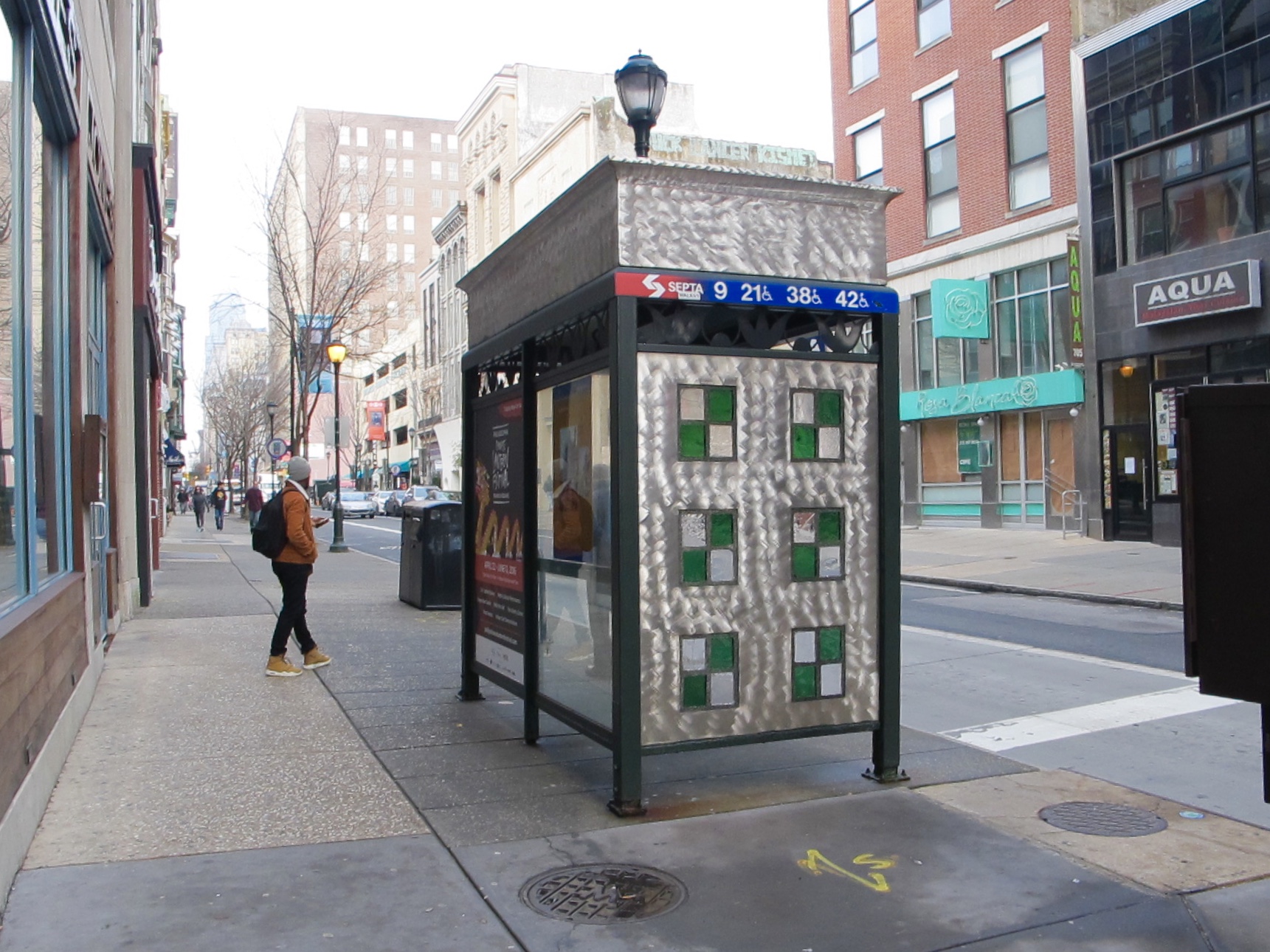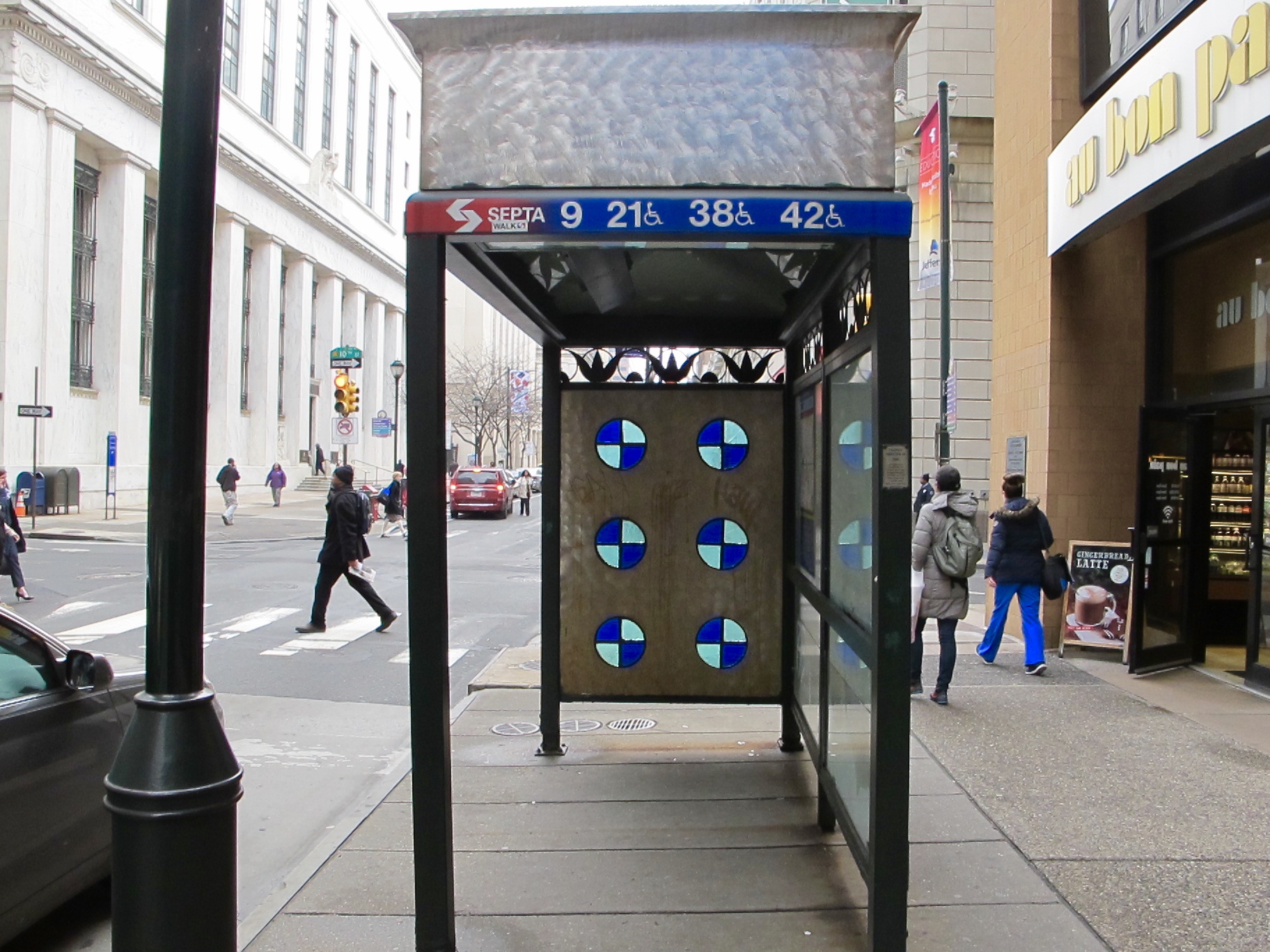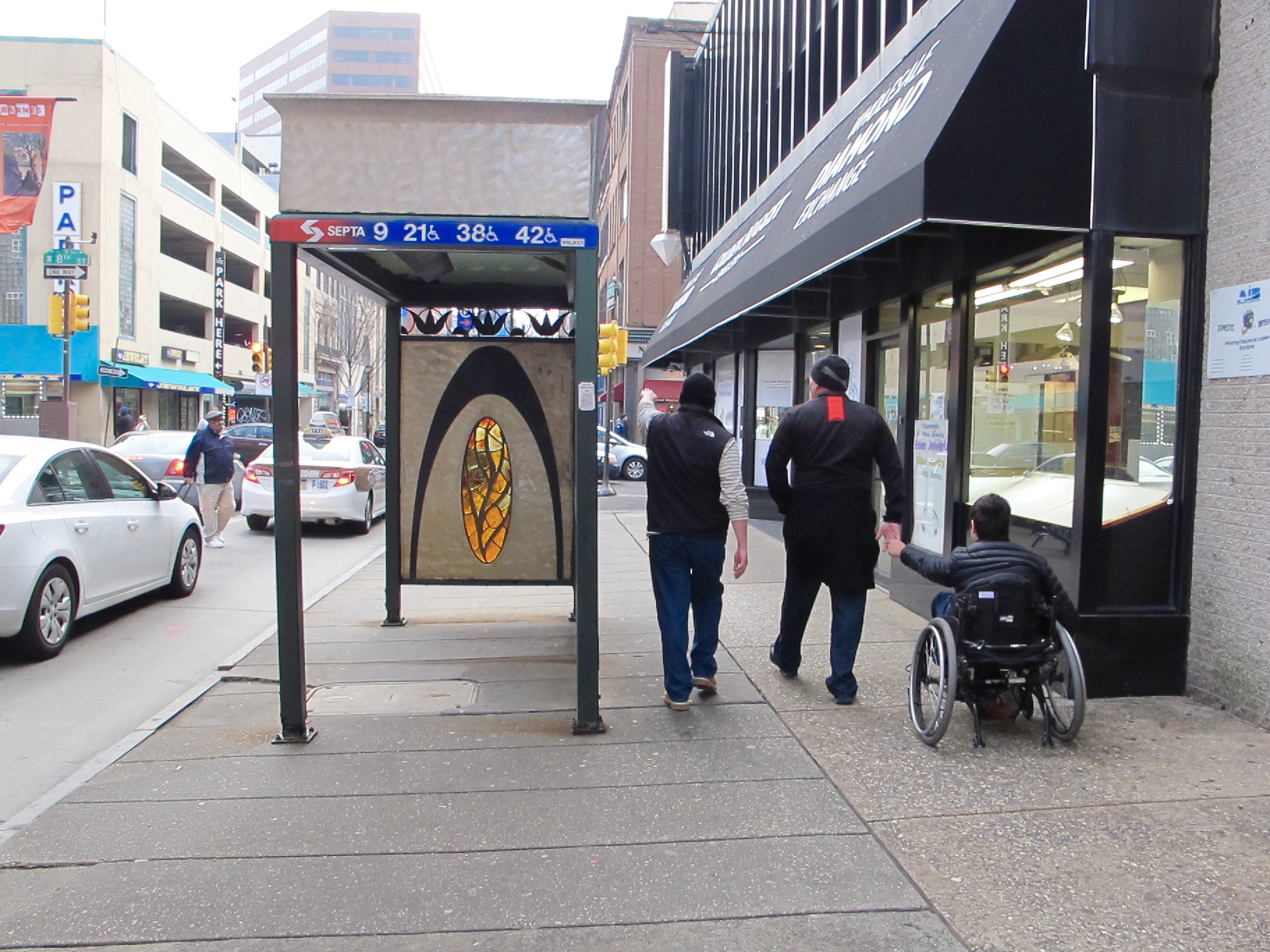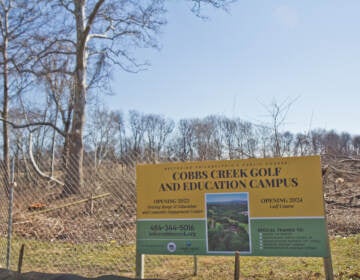City withdraws proposal to scrap Chestnut Street’s art bus shelters

In 1999 the City of Philadelphia commissioned artist Pablo Tauler to adapt 11 bus shelters on Chestnut Street in Center City with site-specific designs. Tauler transformed the drab little pods with thick pieces of colored glass set in steel panels, beautifully refracting light and brightening their corners.
Less than two decades later the city wants to deaccession the Tauler-embellished shelters as part of an ongoing process to install street furniture and expand advertising, which will add hundreds of bus shelters to the city’s inventory and replace older models—including the lively offerings on Chestnut—with new editions featuring benches and digital advertising.
“I talked to Pablo and he was completely understanding and not upset by it,” said Margot Berg, Philadelphia’s Public Art Director in a presentation to the Art Commission on Wednesday. “He understands that these kinds of things happen in the urban environment.”
Tauler seems to be the only one so understanding. The city’s attempt to deaccessioning these bus shelters, created under the Percent for Art program, proved so unpopular with the Art Commission that the city ended up withdrawing the proposal.
Despite being one of the first public meetings of any kind in 2017, a surprisingly robust community opposition turned out to oppose the scrapping of the shelters as well. SEPTA expressed interest in possibly reusing a few of them. Tauler himself was offered them back as well, although he demurred.
“I remember moving here from New York and seeing one of those bus stations,” says Kay Healy, an artist who arrived in Philadelphia ten years ago. (She waited three hours before speaking up in defense of the shelters.) “I remember seeing the light coming through the stained glass and thinking, ‘oh my gosh, this city really cares about art, what a great place for me to have landed.’ This [proposal] is very troubling to me and I urge you to please save them.”
City representatives say that alternatives to replacement were considered in the case of the Chestnut Street shelters. In terms of preserving the artwork itself, Berg explained, she is required to commission artwork but funds are not set aside to maintain it. She also noted that the capital funding available for repairs is covered by very strict eligibility guidelines, for which this particular artwork does not qualify.
Berg said that while deaccessioning is rare, it’s usually attempted when a project proves to have an inherent vice—a fancy term for an unsalvageable problem—that makes it unsustainable as publicly exposed art.
Over the course of the debate, however, the problem seemed less to be Tauler’s art—although Berg notes that graffiti is difficult to remove from glass—and more that the parts needed to repair the old bus shelters are no longer manufactured. From the perspective of Matthew Fisher, Director of Policy for the Office of Transportation and Infrastructure Systems, the shelters are a disservice to those in need because they lack interior lighting or seating.
“I personally walked to each of these shelters and thought wow it’s a shame… the shelters are damaged,” said Fisher. “I’ve heard a lot about reuse and why can’t we repair them? We’ve explored reuse. It was not our first choice to get rid of this. There was the also the comment that there has to be money somewhere. But, well, there’s not money for everything in the city.”
The art commissioners didn’t buy these arguments. As Commissioner Natalie Nixon of Philadelphia University noted, they were merely talking about 1 percent of the eventual 600 shelters. Meanwhile, the contract to replace all the existing shelters will add an additional 300 to the city’s supply. At a cost of an initial $12 million, the digital ads are projected to net the city $100 million in revenues over the next 20 years.
Commissioner after commissioner attacked the deaccessioning attempt for sacrificing art to commerce. After years of what they described as negligible maintenance it seemed that now advertising dollars were at stake, and Tauler’s distinctive project would be sacrificed along with the hundreds of unadorned shelters across the city.
“I think it’s an insult to the city,” said Joe Laragione, a painter who sits on the commission. “It’s ludicrous, taking down works of art and replacing it with advertisements.”
Mary Tracy of Scenic Philadelphia added her voice to the dissenters.* Her argument, and those of her supporters, hinged on the notion that public art would be scrapped for private profit. After ferociously arguing her point, Tracey then read off statement from other defenders of the Chestnut Street shelters. Almost all of them lashed out against what they characterized as an increasing trend towards placing advertisements on every available surface.
“Yesterday, returning to work I read over the agenda and said holy mackerel people don’t even know about this,” said Tracey. “We forget that people work and can’t sit here for 3 hours and tell you how they feel. 99 percent of the time they don’t even know these decisions are being made that will affect our city forever.”
Chairman Alan Greenberger argued that the commission shouldn’t focus on the advertising or the economics. He also warned that deaccessioning, even if it is rare, is a part of the Commission’s mission too.
“We are not here to keep everything in place,” said Greenberger. “Buildings get torn down, landscapes get changed and occasionally, I guess, art work gets offered for deaccession. I’m not suggesting that as a point of view, just saying it’s a legitimate part of our mission.”
But not one the commissioners wanted a part of it on Wednesday. The commissioners proposed feasibility studies of reuse and preservation. Or perhaps a dialogue between all the stakeholders could be arranged to discuss the future of the Chestnut Street shelters. A flat out rejection of the proposal got heads nodding as well.
The details of what would happen next were not to be hashed out at January’s Art Commission meeting. The body’s near-universal opposition caused the deaccessioning proposal to simply be withdrawn entirely for the time being.
*Mary Tracy has a seat on PlanPhilly’s Community Advisory Board.
WHYY is your source for fact-based, in-depth journalism and information. As a nonprofit organization, we rely on financial support from readers like you. Please give today.







